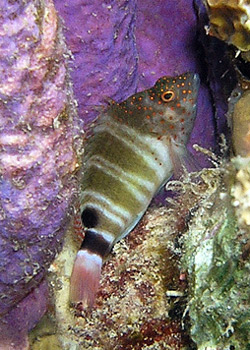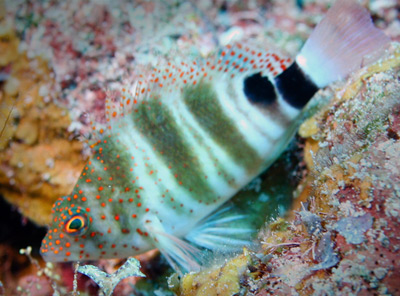Regular Saltwater Smarts visitors know that “Caribbean Chris” has an irrational (bordering on pathological) hatred of all marine life not connected in some way to the Caribbean Sea or tropical western Atlantic. By logical extension, most of the hawkfishes, being predominantly Indo-Pacific or Pacific species, are unwelcome in his aquarium. (He may even have a sign posted next to his tank that reads “Hawkfishes need not apply,” or some such. I could be wrong.)
This manifestation of CC’s shameless “saltwater segregation” is unfortunate because many of the hawkfishes make outstanding aquarium candidates, being very hardy, interesting, easy to feed, and, with some exceptions, well suited to modest-sized systems.
However, notwithstanding CC’s unabashed regional biases, there is at least one hawkfish species that even he can’t deny fits right in with his Caribbean-centric theme—the redspotted, aka Caribbean, hawkfish (Amblycirrhitus pinos).
Physical traits

A. pinos has a squat, vaguely (American) football-shaped body; high-set eyes that closely follow activity inside and outside the tank; oversized pectoral fins on which it props itself; and short, hair-like cirri forming a tassel that resembles a coral polyp atop each dorsal spine. Maximum length for this species is between 3 and 4 inches.
Color-wise, A. pinos features alternating cream and brown vertical bands along its flanks, with narrower, yellowish-brown vertical stripes bisecting the cream-colored bands. The band nearest the caudal peduncle is darker than the rest, and just anterior to the caudal peduncle is a dark blotch that could be said to create an “eye spot.” Tiny red dots freckle the head and dorsal fin, and the tail fin is pinkish.
Feeding
The natural diet of A. pinos consists of small crustaceans and their larvae as well as polychaete worms. Aquarium specimens will accept just about any small, meaty food items, such as mysids, chopped crustacean or mollusk meat, blackworms, and frozen formulations for small carnivores (e.g., Reef Frenzy Nano). Dry pellets and flakes may also be accepted. Once- to twice-per-day feedings are sufficient for this species.
Housing
Because A. pinos lacks a swim bladder and spends most of its time on the rockwork, it doesn’t demand a lot of open swimming space. A tank as small as 20 gallons can be considered adequate housing. Be sure the tank is aquascaped to provide lots of ledges for the hawk to “perch” upon as well as caves and hidey holes in which it can refuge.
Compatibility
A. pinos is moderately aggressive and, once established, may squabble with smaller, more passive fishes or other benthic species. Otherwise, it should get along fine with most tankmates that aren’t inclined to belligerence themselves.
This species can generally be considered a good candidate for reef systems with the caveat that, like any hawkfish, it may develop the habit of perching on top of coral specimens. If persistently directed at the same coral specimen, this behavior may irritate the coral and cause it to remain in a contracted state.



